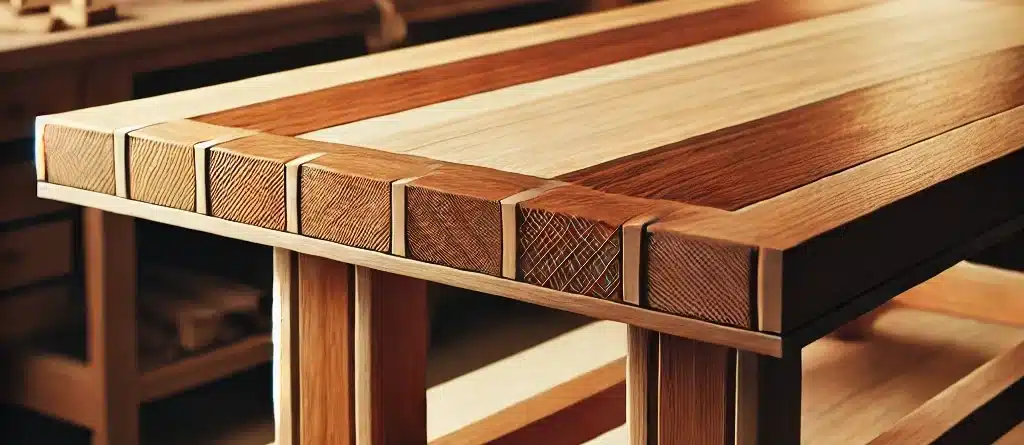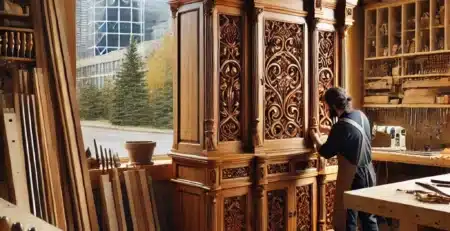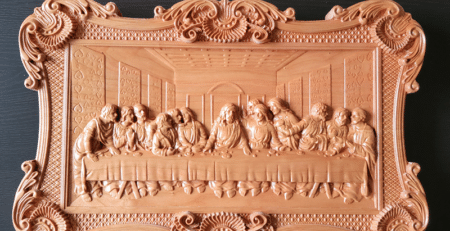Woodworking: Crafting with Skill, Precision, and Passion
Mastering the Art of Woodworking: A Guide to Craftsmanship and Creativity
Introduction
Woodworking is more than just a skill; it’s an art form that combines precision, creativity, and a deep respect for materials. As one of the oldest crafts, woodworking has evolved from simple carpentry into a versatile practice encompassing furniture making, carving, cabinetry, and intricate detailing. In today’s DIY culture, woodworking remains a popular and fulfilling hobby, drawing enthusiasts from all walks of life. This article explores the essentials of woodworking, from tools and materials to techniques and sustainable practices, providing insights for both beginners and seasoned woodworkers.
Whether you’re looking to start a simple project or create custom pieces, understanding the fundamentals of woodworking can unlock a world of creative possibilities. At The Original Workshop, our passion for woodworking drives us to craft unique, custom-made items that stand the test of time. Join us on this journey to discover the beauty of woodworking and learn what makes this craft so enduring and rewarding.
What is Woodworking?
Woodworking refers to the craft of shaping, joining, and finishing wood to create objects of both functional and artistic value. This includes furniture, decorative items, tools, and structures. While carpentry is often associated with building structures, woodworking encompasses a broader range of skills and projects, allowing artisans to create everything from sturdy tables to delicate sculptures.
At The Original Workshop, woodworking is at the heart of our work. We craft each item with precision and an eye for detail, tailoring each piece to meet our clients’ unique visions. As you dive into woodworking, you’ll find it is an incredibly flexible craft, with projects that can suit nearly any skill level or purpose.
Essential Tools and Materials in Woodworking
The tools and materials you choose are critical to the quality and efficiency of your work. While woodworking can seem tool-intensive, starting with the basics is the best way to build your skills and gradually expand your toolkit.
1. Basic Tools for Woodworking
- Saws: The hand saw, circular saw, and jigsaw are essential for cutting wood into various shapes and sizes. While power tools can speed up the process, learning to use a hand saw builds foundational skills.
- Chisels: Chisels come in various sizes and shapes and are essential for carving, detailing, and creating joints. Keeping them sharp is key to effective use.
- Drills: Drills allow you to create holes and assemble pieces with screws. A good cordless drill is versatile and an asset to any woodworker.
- Measuring Tools: Precise measurements are essential in woodworking. A tape measure, combination square, and ruler are fundamental to accuracy.
- Clamps: Clamps hold pieces in place while glue dries or cuts are made. They are invaluable when assembling and securing materials.
2. Types of Wood for Woodworking
- Hardwoods: Woods like oak, maple, and cherry are durable and often used for high-quality furniture. They offer a smooth finish and are resistant to wear.
- Softwoods: Softwoods such as pine and cedar are easier to work with and more affordable. They’re commonly used for general construction and beginner projects.
- Engineered Wood: Plywood and MDF (medium-density fiberboard) are made by bonding wood particles or layers together. While not as durable as solid wood, these materials are affordable and versatile for many projects.
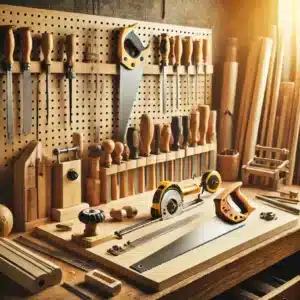 Techniques and Skills to Master in Woodworking
Techniques and Skills to Master in Woodworking
As you develop your woodworking skills, mastering basic techniques can help you create high-quality projects. Here are a few foundational skills to get started with.
1. Joinery Techniques Joinery refers to the methods used to connect pieces of wood without nails or screws. Popular techniques include:
- Dovetail Joints: Known for their interlocking pins and tails, dovetail joints are commonly used in drawer construction and add a beautiful visual element.
- Mortise and Tenon Joints: This classic joint involves fitting a tenon (a tongue-like protrusion) into a mortise (a corresponding hole). Mortise and tenon joints are strong and ideal for framing.
- Butt Joints and Pocket Holes: The simplest joints, butt joints are formed by joining two pieces at their edges. Pocket holes add strength and are commonly used in furniture making.
2. Sanding and Finishing Sanding smooths the surface of the wood, preparing it for a finish. Begin with coarse grit sandpaper and progress to finer grits for a smooth finish. Finishing products, such as stains, oils, and varnishes, enhance the wood’s natural beauty while protecting it from moisture and wear.
3. Wood Carving and Shaping Wood carving is an art in itself and can bring a project to life. Using gouges, chisels, and knives, carvers can create intricate details and add character to their work. At The Original Workshop, we emphasize these techniques in our custom pieces, ensuring each item has a distinct, handcrafted quality.
Safety Tips for Woodworking
Working with wood and power tools requires attention to safety. A few essential safety tips can help prevent accidents and make your workspace more comfortable.
- Wear Protective Gear: Safety glasses, ear protection, and gloves are essential when using power tools. A dust mask is also recommended to avoid inhaling sawdust.
- Work in a Clean Space: An organized workspace reduces accidents. Keep your tools, materials, and work surface tidy.
- Keep Tools Sharp: Dull tools require more force, increasing the risk of slips and injuries. Regularly sharpen your tools to ensure they are safe and effective.
- Practice Good Lighting and Ventilation: A well-lit workspace allows you to see your work clearly, while ventilation helps manage dust and fumes from finishes or adhesives.
Popular Woodworking Projects and Ideas
Woodworking projects range from simple decor items to complex furniture. Here are a few project ideas to inspire your next creation:
- Shelves and Storage: Floating shelves, bookcases, and storage units are practical and relatively easy to build. They can be customized in size and style to fit your space.
- Tables and Benches: From coffee tables to dining benches, tables are versatile projects that can be tailored with various finishes and styles.
- Wall Art and Signage: Carving words or images into wood is a great way to personalize a space. At The Original Workshop, our custom signage combines craftsmanship with personal design.
- Holiday Decor and Gifts: Personalized cutting boards, wood ornaments, and custom picture frames make thoughtful gifts. With the holidays approaching, these projects are both useful and meaningful.
Sustainability and Woodworking
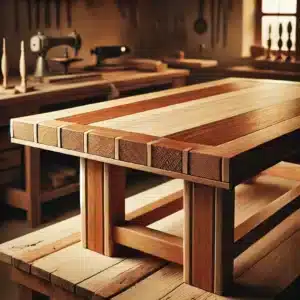 With environmental concerns growing, many woodworkers are turning to sustainable practices. Using reclaimed wood, which is wood salvaged from old buildings, fences, or furniture, reduces waste and adds character to your projects. Woodworking also encourages using natural finishes and locally sourced materials to minimize the environmental impact.
With environmental concerns growing, many woodworkers are turning to sustainable practices. Using reclaimed wood, which is wood salvaged from old buildings, fences, or furniture, reduces waste and adds character to your projects. Woodworking also encourages using natural finishes and locally sourced materials to minimize the environmental impact.
At The Original Workshop, we emphasize sustainability by selecting wood from reputable suppliers and choosing eco-friendly finishes. By valuing durability and responsible sourcing, woodworking can contribute to a more sustainable lifestyle and promote mindful craftsmanship.
The History of Woodworking: A Timeless Craft
To truly appreciate woodworking, it’s helpful to understand its history. Woodworking dates back thousands of years, with early examples found in ancient Egyptian and Mesopotamian civilizations. From building tools and furniture to constructing temples and ships, woodworking was essential to daily life.
In the Middle Ages, woodworking evolved significantly as artisans developed more specialized tools and techniques. Woodworkers in Europe formed guilds, passing down their skills through apprenticeships and transforming woodworking into a respected trade. The Industrial Revolution brought about machines that could mass-produce items, but the art of handcrafting wood endured.
Today, woodworking enjoys a renaissance as people seek out handmade items that emphasize quality and craftsmanship. At The Original Workshop, we honor these traditions by combining classic techniques with modern designs, ensuring that each piece we create has a story to tell.
Types of Woodworking: Carpentry, Cabinetmaking, Carving, and More
The scope of woodworking is vast, with various specialties that cater to different aspects of the craft. Here’s a closer look at some of the key areas within woodworking:
- Carpentry: This foundational form of woodworking involves constructing buildings, frames, and structures. Carpenters work on everything from house framing to interior trim, ensuring structures are sturdy and aesthetically pleasing.
- Cabinetmaking: Cabinetmakers focus on crafting furniture and storage solutions, such as cabinets, tables, and chairs. This area of woodworking requires precision, as each piece must fit perfectly in a given space.
- Wood Carving: A more artistic form of woodworking, carving involves shaping wood to create detailed designs and sculptures. Carvers use tools like gouges and chisels to bring intricate designs to life, often using softer woods like basswood or butternut for ease of carving.
- Woodturning: Woodturning is a unique technique where wood is spun on a lathe, allowing the woodworker to shape it into rounded objects like bowls, vases, or furniture legs. The Original Workshop frequently uses woodturning for decorative and functional pieces alike.
- Joinery and Fine Woodworking: This highly skilled form of woodworking is focused on creating fine details and complex joints that enhance both the beauty and structural integrity of a piece. Joinery techniques, as mentioned, include dovetails, mortise and tenon, and more.
Understanding these different types can help new woodworkers decide which area to focus on, as each offers its own set of skills and projects.
Advanced Woodworking Techniques to Explore
Once you’ve mastered the basics, there are plenty of advanced techniques that can elevate your work. Here are a few worth exploring:
- Inlay Work: Inlaying involves embedding pieces of contrasting materials, like mother of pearl or different types of wood, into a base wood to create patterns. It’s a technique that requires patience and precision but adds incredible detail to a piece.
- Veneering: This technique involves applying a thin layer of high-quality wood over a more affordable base, allowing for luxurious finishes without the cost of solid wood. Veneering is commonly used in furniture-making and cabinetry.
- Bent Lamination: By gluing thin layers of wood together and bending them into a specific shape, woodworkers can create curved elements that are both strong and visually appealing. This technique is often seen in modern furniture design.
Each of these advanced techniques can add a unique flair to woodworking projects, allowing you to craft pieces that stand out. At The Original Workshop, we incorporate these techniques into our custom designs to create pieces that are both beautiful and functional.
Tips for Setting Up a Woodworking Workshop
Creating a dedicated space for woodworking is essential for serious woodworkers. Here are some tips to help you set up an efficient and safe workspace:
- Choose a Spacious Area: A garage, basement, or dedicated workshop area is ideal. Make sure there’s ample room for workbenches, tool storage, and enough space to move around safely.
- Organize Your Tools: Keep your most-used tools within easy reach and arrange them in a way that reduces clutter. Wall-mounted pegboards, cabinets, and tool racks can help keep your space organized.
- Lighting and Ventilation: Good lighting is essential for detailed work, while proper ventilation helps reduce dust and fumes from finishes. Consider adding windows or a ventilation fan to improve air circulation.
- Power Outlets and Safety Features: If you’re using power tools, ensure you have enough outlets nearby and consider installing a dust collection system to keep the area clean and safe.
Investing in your workshop setup can make woodworking more enjoyable and efficient, ultimately helping you produce better-quality work.
Common Woodworking Mistakes and How to Avoid Them
As with any skill, woodworking involves a learning curve, and mistakes are part of the process. Here are some common errors and tips on how to avoid them:
- Inaccurate Measurements: This is a common pitfall, especially for beginners. Always measure twice before cutting to avoid costly errors.
- Using the Wrong Type of Wood: Different projects call for different types of wood. Understanding the characteristics of various woods can help you choose the best option for each project.
- Skipping the Sanding Process: Sanding can be time-consuming, but it’s essential for achieving a smooth, professional finish. Rushing through sanding can leave unsightly marks on the final product.
- Overuse of Glue: When gluing joints, less is more. Too much glue can create a mess and weaken the bond. Apply just enough to create a solid joint, and be sure to clean off any excess.
By being mindful of these potential mistakes, woodworkers can improve their skills and produce higher-quality results.
The Benefits of Custom Woodworking
Custom woodworking offers a unique opportunity to bring your vision to life. Unlike mass-produced items, custom wood pieces are tailored to specific preferences and spaces, allowing for personal touches that reflect individual style. Custom woodworking also ensures that each piece is built to last, using quality materials and expert craftsmanship.
At The Original Workshop, we specialize in custom woodworking, working closely with clients to design and build pieces that suit their needs and aesthetic. From custom cabinetry to one-of-a-kind furniture, our team is dedicated to creating items that add both beauty and functionality to your space.
How to Get Started with Woodworking
For those interested in learning woodworking, the best approach is to start small and gradually build your skills. Here’s a step-by-step guide to help you get started:
- Learn the Basics: Familiarize yourself with essential tools and basic techniques. Start with a few simple projects to get comfortable with handling tools and materials.
- Take Classes or Watch Tutorials: Many community centers, schools, and online platforms offer woodworking classes. YouTube is also a valuable resource for learning specific techniques.
- Practice Consistently: Woodworking, like any skill, improves with practice. Dedicate regular time to work on projects, and don’t be afraid to make mistakes along the way.
- Seek Out Inspiration: Follow woodworking blogs, join online forums, and visit websites like The Original Workshop for ideas and guidance. Observing other woodworkers can provide inspiration and insight into different styles and techniques.
Starting with simple projects and expanding to more complex pieces as your skills grow will make the learning process both enjoyable and rewarding.
Conclusion
Woodworking is a craft that bridges functionality and artistry, offering endless possibilities for customization and expression. From selecting the right tools and materials to mastering joinery and finishing techniques, the journey of woodworking is both rewarding and transformative. Each project allows woodworkers to connect with their creativity and develop skills that produce lasting, beautiful results.
Whether you’re just starting or looking to deepen your expertise, woodworking is a skill that continues to inspire. At The Original Workshop, we take pride in crafting unique, high-quality items that bring our clients’ visions to life. Dive into the world of woodworking and discover the satisfaction of creating something meaningful with your own hands.


